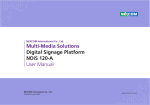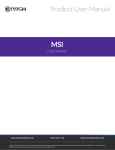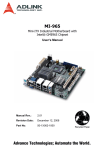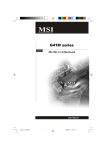Download BCM Advanced Research FX815ELT User`s manual
Transcript
Intel® CoreTM 2 Duo/CoreTM Duo CoreTM Solo/Pentium Dual-Core/Celeron® M Mini ITX Mainboard MX945GME User’s Manual v1.05 http://www.bcmcom.com MX945GME FCC Statement THIS DEVICE COMPLIES WITH PART 15 FCC RULES. OPERATION IS SUBJECT TO THE FOLLOWING TWO CONDITIONS: (1) THIS DEVICE MAY NOT CAUSE HARMFUL INTERFERENCE. (2) THIS DEVICE MUST ACCEPT ANY INTERFERENCE RECEIVED INCLUDING INTERFERENCE THAT MAY CAUSE UNDESIRED OPERATION. THIS EQUIPMENT HAS BEEN TESTED AND FOUND TO COMPLY WITH THE LIMITS FOR A CLASS "A" DIGITAL DEVICE, PURSUANT TO PART 15 OF THE FCC RULES. THESE LIMITS ARE DESIGNED TO PROVIDE REASONABLE PROTECTION AGAINST HARMFUL INTERFERENCE WHEN THE EQUIPMENT IS OPERATED IN A COMMERCIAL ENVIRONMENT. THIS EQUIPMENT GENERATES, USES, AND CAN RADIATE RADIO FREQUENCY ENERGY AND, IF NOT INSTATLLED AND USED IN ACCORDANCE WITH THE INSTRUCTION MANUAL, MAY CAUSE HARMFUL INTERFERENCE TO RADIO COMMUNICATIONS. OPERATION OF THIS EQUIPMENT IN A RESIDENTIAL AREA IS LIKELY TO CAUSE HARMFUL INTERFERENCE IN WHICH CASE THE USER WILL BE REQUIRED TO CORRECT THE INTERFERENCE AT HIS OWN EXPENSE. Notice This guide is designed for experienced users to setup the system within the shortest time. For detailed information, please always refer to the electronic user's manual. Copyright Notice Copyright © 2006 BCM Advanced Research. ALL RIGHTS RESERVED. No part of this document may be reproduced, copied, translated, or transmitted in any form or by any means, electronic or mechanical, for any purpose, without the prior written permission of the original manufacturer. Trademark Acknowledgement Brand and product names are trademarks or registered trademarks of their respective owners. i User’s Manual User’s Manual Disclaimer BCM Advanced Research reserves the right to make changes, without notice, to any product, including circuits and/or software described or contained in this manual in order to improve design and/or performance. BCM assumes no responsibility or liability for the use of the described product(s), conveys no license or title under any patent, copyright, or masks work rights to these products, and makes no representations or warranties that these products are free from patent, copyright, or mask work right infringement, unless otherwise specified. Applications that are described in this manual are for illustration purposes only. BCM makes no representation or warranty that such application will be suitable for the specified use without further testing or modification. Life Support Policy BCM Advanced Research PRODUCTS ARE NOT FOR USE AS CRITICAL COMPONENTS IN LIFE SUPPORT DEVICES OR SYSTEMS WITHOUT THE PRIOR WRITTEN APPROVAL OF BCM Advanced Research. As used herein: 1. Life support devices or systems are devices or systems which, (a) are intended for surgical implant into body, or (b) support or sustain life and whose failure to perform, when properly used in accordance with instructions for use provided in the labeling, can be reasonably expected to result in significant injury to the user. 2. A critical component is any component of a life support device or system whose failure to perform can be reasonably expected to cause the failure of the life support device or system, or to affect its safety or effectiveness. ii User’s Manual MX945GME Technical Support We want you to get the maximum performance from your products. So if you run into technical difficulties, we are here to help. For the most frequently asked questions, you can easily find answers in your product documentation. These answers are normally a lot more detailed than the ones we can give over the phone. So please consult the user’s manual first. To receive the latest version of the user’s manual; please visit our Web site at: http://www.bcmcom.com/ If you still cannot find the answer, gather all the information or questions that apply to your problem, and with the product close at hand, call your dealer. Our dealers are well trained and ready to give you the support you need to get the most from your BCM products. In fact, most problems reported are minor and are able to be easily solved over the phone. In addition, free technical support is available from BCM engineers every business day. We are always ready to give advice on application requirements or specific information on the installation and operation of any of our products. Please do not hesitate to call or e-mail us. BCM Advanced Research. 7 Marconi, Irvine, CA, 92618 U.S.A Tel : 949-470-1888 Fax :949-470-0971 http://www.bcmcom.com E-mail: [email protected] iii User’s Manual User’s Manual Product Warranty BCM warrants to you, the original purchaser, that each of its products will be free from defects in materials and workmanship for one year from the date of purchase. This warranty does not apply to any products which have been repaired or altered by persons other than repair personnel authorized by BCM, or which have been subject to misuse, abuse, accident or improper installation. BCM assumes no liability under the terms of this warranty as a consequence of such events. Because of BCM high quality-control standards and rigorous testing, most of our customers never need to use our repair service. If any of BCM products is defective, it will be repaired or replaced at no charge during the warranty period. For out-of-warranty repairs, you will be billed according to the cost of replacement materials, service time, and freight. Please consult your dealer for more details. If you think you have a defective product, follow these steps: 1. Collect all the information about the problem encountered. (For example, CPU type and speed, BCM products model name, hardware & BIOS revision number, other hardware and software used, etc.) Note anything abnormal and list any on-screen messages you get when the problem occurs. 2. Call your dealer and describe the problem. Please have your manual, product, and any helpful information available. 3. If your product is diagnosed as defective, obtain an RMA (return material authorization) number from your dealer. This allows us to process your good return more quickly. 4. Carefully pack the defective product, a complete Repair and Replacement Order Card and a photocopy proof of purchase date (such as your sales receipt) in a shippable container. A product returned without proof of the purchase date is not eligible for warranty service. 5. Write the RMA number visibly on the outside of the package and ship it prepaid to your dealer. iv User’s Manual CONTENTS FCC Statement .................................................................................................. i Copyright Notice................................................................................................. i Trademark ......................................................................................................... i Disclaimer ..........................................................................................................ii Life Support Policy .............................................................................................ii Technical Support .............................................................................................iii Product Warranty ..............................................................................................iv Contents............................................................................................................ v Chapter 1 Getting Started............................................................................ 1-1 Mainboard Specifications ......................................................................... 1-2 Mainboard Layout .................................................................................... 1-4 Chapter 2 Hardware Setup .......................................................................... 2-1 Quick Components Guide ........................................................................ 2-2 CPU (Central Processing Unit)................................................................. 2-3 CPU & Cooler Set Installation ........................................................... 2-4 Memory .................................................................................................... 2-6 Installing DDRII Modules.................................................................... 2-6 Power Supply ........................................................................................... 2-7 ATX 20-Pin System Power Connector: ATX1 .................................... 2-7 Back Panel ............................................................................................... 2-8 Connectors................................................................................................ 2-8 Chassis Intrusion Switch Connector: JCI1 ......................................... 2-9 44-Pin IDE Connector: IDE1 .............................................................. 2-9 Serial ATA Connectors: SATA1, SATA2 .......................................... 2-10 Audio Amplifier Connector: JAMP1 .................................................. 2-11 Front Audio Connector: JAUD1......................................................... 2-11 Fan Power Connectors: CPUFAN1, SYSFAN1................................ 2-12 Front Panel Connector: JFP1........................................................... 2-12 Serial Port Connector: J2 ................................................................. 2-13 Front USB Connector: F_USB2 ....................................................... 2-14 Digital IO Connector: J3 ................................................................... 2-15 Parallel Port Header: JLPT1 ............................................................. 2-15 LVDS Flat Panel Connector: JLVDS1 .............................................. 2-16 Jumpers ................................................................................................. 2-17 LVDS Power Selection Jumper: J1 .................................................. 2-17 COM Port Power Jumpers: J4 – J7 ………………............................ 2-17 Clear CMOS Jumper: CLR_CMOS1 ................................................ 2-17 Slots ....................................................................................................... 2-18 PCI (Peripheral Component Interconnect) Express Slot .................. 2-18 PCI (Peripheral Component Interconnect) Slot ................................ 2-18 PCI Interrupt Request Routing ......................................................... 2-18 v Chapter 3 BIOS Setup ................................................................................... 3-1 Entering Setup .......................................................................................... 3-2 Control Keys......................................................................................... 3-3 Getting Help ........................................................................................ 3-3 General Help <F1>.............................................................................. 3-3 The Menu Bar ........................................................................................... 3-4 Main .......................................................................................................... 3-4 Advanced .................................................................................................. 3-6 PC Health................................................................................................. 3-16 Security ................................................................................................... 3-18 System .................................................................................................... 3-20 Boot.......................................................................................................... 3-20 Exit.................................................................................................................. 3-22 vi Getting Started Chapter 1 Getting Started Thank you for choosing the MX945GME v2.X Mini ITX mainboard from BCM. Based on the innovative Intel® 945GME & ICH7M controllers for optimal system efficiency, the MX945GME accommodates the latest Intel® CoreTM 2 Duo/CoreTM Duo/CoreTM Solo/Pentium Dual-Core/Celeron® M processors in Socket M and supports one 240-pin 533/667MHz DDRII DIMM to provide the maximum of 2GB memory capacity. In the entry-level and mid-range market segment, the MX945GME can provide a high-performance solution for today’s front-end and general purpose workstation, as well as in the future. 1-1 MX945GME Mainboard Mainboard Specifications Processor Support - Intel® CoreTM 2 Duo/CoreTM Duo/CoreTM Solo/Pentium Dual-Core/Celeron® M CPU in Socket M - Supports 3 pin CPU Fan Pin-Header with Fan Speed Control - Supports FSB 53/667MHz Chipset - North Bridge: Intel® 945GME chipset - South Bridge: Intel® ICH7M chipset Memory Support - DDRII 533/667 SDRAM (2GB Max) - 1 DDRII DIMM slot (240pin / 1.8V) LAN - Supports 2 PCI Express Gb Ethernet by Intel 82573L or Intel 82562GZ 10/100 LAN (optional) Audio - HDA Codec by Realtek® ALC888 7.1 channel - Compliant with Azalia 1.0 Spec. - 6 watt amplifier IDE - 1 IDE port by ICH7M - Supports Ultra DMA 66/100 mode - Supports PIO, Bus Master operation mode SATA - SATA ports by ICH7M - Supports two SATA devices - Supports storage and data transfers at up to 150MB/s Connectors Back Panel - 2 RJ-45 LAN jacks - 2 USB 2.0 ports - 1 D-Sub VGA connector - 1 serial port - 1 PS2 keyboard/mouse port - 1 Line-In/Line-Out/Mic-In stacked audio jack Onboard Pinheaders - 1 USB 2.0 pinheader (2 ports) - 1 parallel port pinheader - 1 front audio pinheader - 1 LVDS connector 1-2 Getting Started - 1 Digital I/O pinheader (16GPIO) - 4 COM port headers for COM2~COM5 - 1 front panel pinheader Slots - 1 PCI Express x16 slot (supports ADD2 DVI Card) - 1 PCI Express x 1 slot - 1 PCI 32-bit/33MHz slot Form Factor - Mini ITX Mounting - 4 mounting holes Environmental Storage Temperature - Temperature: -10oC ~ 70oC - Humidity: 10% RH ~ 80% RH Operation Temperature - Temperature: 0oC ~ 60oC - Humidity: 80% RH 1-3 MX945GME Mainboard Mainboard Layout MX945GME v2.X Mini ITX Mainboard 1-4 Hardware Setup Chapter 2 Hardware Setup This chapter provides you with the information about hardware setup procedures. While doing the installation, be careful in holding the components and follow the installation procedures. For some components, if you install in the wrong orientation, the components will not work properly. Use a grounded wrist strap before handling computer Components Static electricity may damage the components. 2-1 MX945GME Mainboard Quick Components Guide 2-2 Hardware Setup CPU (Central Processing Unit) The mainboard supports Intel® CoreTM 2 Duo/CoreTM Duo/CoreTM Solo/Pentium Dual-Core/ Celeron® M processors in Socket M. When you are installing the CPU, make sure the CPU has a heat sink and a cooling fan attached on the top to prevent overheating. If you do not have the heat sink and cooling fan, contact your dealer to purchase and install them before turning on the computer. For more information on compatible components, please visit http://www.bcmcom.com. Important 1. Overheating will seriously damage the CPU and system. Always make sure the cooling fan can work properly to protect the CPU from overheating. 2. Make sure that you apply an even layer of heat sink paste (or thermal tape) between the CPU and the heatsink to enhance heat dissipation. 3. While replacing the CPU, always turn off the ATX power supply or unplug the power supply’s power cord from the grounded outlet first to ensure the safety of CPU. 2-3 MX945GME Mainboard CPU & Cooler Set Installation 1 . Place the CPU on top of the socket. Make sure to align the gold arrow on the CPU with the arrow key on the socket. 2 . Push the CPU the socket. down until 3 . On the front end of the CPU socket is a locking mechanism designed into the form of a screw. Make sure that you actuate or deactuate this mechanism with a screwdriver before and after installing the CPU. 4. Release the metal clips on the retention mechanism. Important Mainboard photos shown in this section are for demonstration only and may differ from the actual look of your mainboard. 2-4 its pins securely fit into Hardware Setup 5 . Mount the cooler set (fan & heatsink bundled) on top of the CPU and fit it into the retention mechanism. 6 . Secure the metal clips back to the retention mechanism. 7 . Connect the fan cable from the mounted fan to the 3-pin power connector on the mainboard. power fan 2-5 MX945GME Mainboard Memory The mainboard provides one 240-pin non-ECC DDRII 533/667 DIMM slot and supports up to 2GB system memory. For more information on compatible components, please visit http://www.bcmcom.com. DDRII 240-pin, 1.8V 64x2=128 pin 56x2=112 pin Single-Channel: All DIMMs in GREEN Installing DDRII Modules 1. The memory module has only one notch on the center and will only fit in the right orientation. 2. Insert the memory module vertically into the DIMM slot. Then push it in until the golden finger on the memory module is deeply inserted in the DIMM slot. Important You can barely see the golden finger if the memory module is properly inserted in the DIMM slot. 3. The plastic clip at each side of the DIMM slot will automatically close. Volt 2-6 Notch Hardware Setup Power Supply ATX 20-Pin System Power Connector: ATX1 This connector allows you to connect to an ATX power supply. To connect to the ATX power supply, make sure the plug of the power supply is inserted in the proper orientation and the pins are aligned. Then push down the power supply firmly into the connector. ATX1 2 0 1 0 1 1 1 ATX1 Pin Definition PIN SIGNAL PIN SIGNAL 1 3.3V 11 3.3V 2 3.3V 12 -12V 3 GND 13 GND 4 5V 14 PS_ON 5 GND 15 GND 6 5V 16 GND 7 GND 17 GND 8 PW_OK 18 -5V 9 5V_SB 19 5V 10 12V 20 5V Important Power supply of 350 watts (and above) is highly recommended for system stability. 2-7 MX945GME Mainboard Back Panel LAN Port Serial Port Mouse Line-In Line-Out Mic-In VGA Port Keyboard USB Ports LAN Ports Serial Port Connector The serial port is a 16550A high speed communications port that sends/ receives 16 bytes FIFOs. You can attach a serial mouse or other serial devices directly to the connector. VGA Connector The DB15-pin female connector is provided for VGA monitors. Mouse/Keyboard Connector The standard PS/2® mouse/keyboard DIN connector is for a PS/2® mouse/keyboard. USB Connectors The OHCI (Open Host Controller Interface) Universal Serial Bus root is for attaching USB devices such as keyboard, mouse, or other USB-compatible devices. Audio Port Connectors These audio connectors are used for audio devices. You can differentiate the color of the audio jacks for different audio sound effects. Blue audio jack - Line In is used for external CD player, tapeplayer or other audio devices. Green audio jack - Line Out, is a connector for speakers or headphones. Pink audio jack - Mic In, is a connector for microphones. LAN (RJ-45) Jack The standard RJ-45 jack is For connection to single Local Area Network (LAN). You can connect a network cable to it. LED Color LED State Left Orange On (steady state) Off Activity Indicator Link Indicator Condition LAN link is not established. LAN link is established. On (brighter & pulsing) The computer is communicating with another computer on the LAN. Green Right Orange 2-8 Off 10 Mbit/sec data rate is selected. On 100 Mbit/sec data rate is selected. On 1000 Mbit/sec data rate is selected. Hardware Setup Connectors Chassis Intrusion Switch Connector: JCI1 This connector connects to a 2-pin chassis switch. If the chassis is opened, the switch will be short. The system will record this status and show a warning message on the screen. To clear the warning, you must enter the BIOS utility and clear the record. CHASSIS GND 1 2 JCI1 44-Pin IDE Connector: IDE1 This 44-pin IDE connector connects to an optional converter that enables connection to one 44-pin IDE device and one 40-pin IDE device, such as hard disk drives, CDROM and other IDE devices. Connect to 44-pin IDE device IDE1 Connect to IDE1 Connect to 40-pin IDE device Important If you install two hard disks on cable, you must configure the second drive to Slave mode by setting its jumper. Refer to the hard disk documentation supplied by hard disk vendors for jumper setting instructions. 2-9 MX945GME Mainboard Serial ATA Connectors: SATA1, SATA2 SATA1~SATA2 are high-speed SATA interface ports and support SATA data rates of 150MB/s. Each SATA connector can connect to 1 hard disk device and is fully compliant with Serial ATA 1.0 specifications. SATA1 SATA2 Serial ATA cable Connect to SATA1/2 Important Please do not fold the Serial ATA cable into 90degree angle. Otherwise, data loss may occur during transmission. 2-10 Hardware Setup Audio Amplifier Connector: JAMP1 The JAMP1 is used to connect audio amplifiers to enhance audio performance. Pin Definition JAMP1 1 PIN SIGNAL 1 AMP_L- 2 AMP_L+ 3 AMP_R- 4 AMP_R+ Front Audio Connector: JAUD1 The JAUD1 connects to an optional audio bracket that provides extra front panel audio IO jacks. 14 13 2 1 Audio Bracket (Optional) JAUD1 JAUD1 Pin Definition PIN SIGNAL PIN SIGNAL 1 5V_SB 2 VCC3 3 SPDF0 4 NA 5 GND 6 SPDF1 7 LEF_OUT 8 SURR_OUT_R 9 CEN_OUT 10 SURR_OUT_L 11 AUD_GPIO21 12 AUDIO GND 13 SIDE_L 14 SIDE_R 2-11 Mainboard Fan Power Connectors: CPUFAN1, SYSFAN1, SYSFAN2 The fan power connectors support system cooling fan with +12V. When connecting the wire to the connectors, always take note that the red wire is the positive and should be connected to the +12V, the black wire is Ground and should be connected to GND. If the mainboard has a System Hardware Monitor chipset on-board, you must use a specially designed fan with speed sensor to take advantage of the CPU fan control. SENSOR SENSOR +12V +12V GND GND SYSFAN1 CPUFAN1 SYSFAN2 Important Please refer to the recommended CPU fans at Intel® / AMD® official website or consult the vendors for proper CPU cooling fan. Front Panel Connector: JFP1 The mainboard provides one front panel connector for electrical connection to the front panel switches and LEDs. The JFP1 is compliant with Intel® Front Panel I/O Connectivity Design Guide. JFP1 10 Power Switch + Power LED 2 9 + Reset - Switch - HDD 1 + LED JFP1 Pin Definition 2-12 PIN SIGNAL DESCRIPTION 1 2 3 4 5 6 7 8 9 10 HD_LED + FP PWR/SLP HD_LED FP PWR/SLP RST_SW PWR_SW + RST_SW + PWR_SW NC KEY Hard disk LED pull-up MSG LED pull-up Hard disk active LED MSG LED pull-up Reset Switch low reference pull-down to GND Power Switch high reference pull-up Reset Switch high reference pull-up Power Switch low reference pull-down to GND No Connection Key Hardware Setup Serial Port Connector: COM2 – COM5 Each RS232 COM port has similar pinouts. Signal Pin Pin Signal NDCD 1 2 NSIN NSOUT 3 4 NDTR GND 5 6 NDSR NRTS 7 8 NCTS VCC_COM 9 10 [KEY] 2-13 MX945GME Mainboard Front USB Connector: F_USB2 The mainboard provides one USB 2.0 pinheader (optional USB 2.0 bracket available) that is compliant with Intel® I/O Connectivity Design Guide. USB 2.0 technology increases data transfer rate up to a maximum throughput of 480Mbps, which is 40 times faster than USB 1.1, and is ideal for connecting high-speed USB interface peripherals such as USB HDD, digital cameras, MP3 players, printers, modems and the like. F_USB2 2 1 10 9 Pin Definition PIN SIGNAL PIN SIGNAL 1 VCC 2 VCC 3 USB0- 4 USB1- 5 USB0+ 6 USB1+ 7 GND 8 GND 9 Key (no pin) 10 USBOC Connected to USB connector USB 2.0 Bracket (Optional) Important Note that the pins of VCC and GND must be connected correctly to avoid possible damage. 2-14 Hardware Setup Digital IO Connector: J3 The J3 connects to the General-Purpose Input/Output (GPIO) peripheral module. J3 Pin Definition J3 19 20 1 2 PIN SIGNAL PIN SIGNAL 1 VCC3 2 VCC5 3 N_GPIO10 4 N_GPIO20 5 N_GPIO11 6 N_GPIO21 7 N_GPIO12 8 N_GPIO22 9 N_GPIO13 10 N_GPIO23 11 N_GPIO14 12 N_GPIO24 13 N_GPIO15 14 N_GPIO25 15 N_GPIO16 16 N_GPIO26 17 N_GPIO17 18 N_GPIO27 19 GND 20 NC Parallel Port Header: JLPT1 The mainboard provides a 26-pin header for connection to a parallel port bracket. The parallel port is a standard printer port that supports Enhanced Parallel Port (EPP) and Extended Capabilities Parallel Port (ECP) mode. JLPT1 Parallel Port Bracket 26 25 2 1 Pin Signal Name Pin Signal Name 1 RSTB# 2 AFD# 3 PRND0 4 ERR# 5 PRND1 6 PINIT# 7 PRND2 8 LPT_SLIN# 9 PRND3 10 GND 11 PRND4 12 GND 13 PRND5 14 GND 15 PRND6 16 GND 17 PRND7 18 GND 19 ACK# 20 GND 21 BUSY 22 GND 23 PE 24 GND 25 SLCT 26 GND 2-15 MX945GME LVDS Mainboard Flat Panel Connector: JLVDS1 The LVDS (Low Voltage Differential Signal) connector provides a digital interface typically used with flat panels. After connecting an LVDS interfaced flat panel to the JLVDS1, be sure to check the panel datasheet and set the J1 LVDS Power Selection Jumper SIGNAL PIN to a proper voltage. +12V 2 1 +12V +12V 4 3 +12V GND 6 5 +12V GND 8 7 +3V LCDVCC 10 9 LCDVCC DDC DATA 12 11 DDC CLK VDD ENABLE 14 13 BKLTCTL GND 16 15 BKLTEN LVDS A0+ 18 17 LVDS A0- LVDS A1+ 20 19 LVDS A1- LVDS A2+ 22 21 LVDS A2- LVDS ACLK+ 24 23 LVDS ACLK- LVDS A3+ 26 25 LVDS A3- GND 28 27 GND LVDS B0+ 30 29 LVDS B0- LVDS B1+ 32 31 LVDS B1- LVDS B2+ 34 33 LVDS B2- LVDS BCLK+ 36 35 LVDS BCLK- LVDS B3+ 38 37 LVDS B3+ 40 39 GND JLVDS1 2 40 1 39 GND After hardware installation is done, select the LVDS panel type and tune the LVDS backlight in the BIOS Setup Utility. 2-16 SIGNAL Hardware Setup Jumpers LVDS Power Selection Jumper: J1 Use this jumper to specify the LVDS power. 1 J1 Pin Signal Name 1 VCC3 2 LCD_SRC (default VCC3) 3 VCC5 Voltage Select for COM2-COM5: J4 - J7 COM Port Power Jumpers: JCOMP4, JCOMP5 These jumpers specify the operation voltage of the serial ports COM2 – COM5. J4 -> COM2 J5 -> COM3 J6 -> COM5 J7 -> COM4 +5V AT/ATX Mode: J8 +12V 3 This jumper specifies AT 1or ATX mode 1 3 operation behavior. JCOMP5 1 3 +5V +12V Clear CMOS Jumper: CLR_CMOS1 There is a CMOS RAM onboard that has a power supply from external battery to keep the data of system configuration. With the CMOS RAM, the system can automatically boot OS every time it is turned on. If you want to clear the system configuration, set the CLR_CMOS1 (Clear CMOS Jumper ) to clear data. 1 1 3 3 1 CLR_CMOS1 Clear Data Keep Data Important You can clear CMOS by shorting 1-2 pin while the system is off. Then return to 2-3 pin position. Avoid clearing the CMOS while the system is on; it will damage the mainboard. 2-17 MX945GME Mainboard Slots PCI ( Peripheral Component Interconnect ) Express Slot PCI Express architecture provides a high performance I/O infrastructure for Desktop Platforms with transfer rates starting at 2.5 Giga transfers per second over a PCI Express x1 lane for Gigabit Ethernet, TV Tuners, 1394 controllers, and general purpose I/O. Also, desktop platforms with PCI Express Architecture will be designed to deliver highest performance in video, graphics, multimedia and other sophisticated applications. Moreover, PCI Express architecture provides a high performance graphics infrastructure for Desktop Platforms doubling the capability of existing AGP 8x designs with transfer rates of 4.0 GB/s over a PCI Express x16 lane for graphics controllers, while PCI Express x1 supports transfer rate of 250 MB/s. PCI Express x16 Slot PCI Express x1 Slot PCI (Peripheral Component Interconnect) Slot The PCI slot supports LAN cards, SCSI cards, USB cards, and other add-on cards that comply with PCI specifications. At 32 bits and 33 MHz, it yields a throughput rate of 133 MBps. 32-bit PCI Slot PCI Interrupt Request Routing The IRQ, acronym of interrupt request line and pronounced I-R-Q, are hardware lines over which devices can send interrupt signals to the microprocessor. The PCI IRQ pins are typically connected to the PCI bus pins as follows: 32-bit PCI1 Order 1 Order 2 Order 3 Order 4 INT A# INT B# INT C# INT D# Important When adding or removing expansion cards , make sure that you unplug the power supply first. Meanwhile , read the documentation for the expansion card to configure any necessary hardware or software settings for the expansion card , such as jumpers , switches or BIOS configuration. 2-18 BIOS Setup Chapter 3 BIOS Setup This chapter provides information on the BIOS Setup program and allows you to configure the system for optimum use. You may need to run the Setup program when: ² An error message appears on the screen during the system booting up, and requests you to run SETUP. ² You want to change the default settings for customized features. 3-1 MX945GME Mainboard Entering Setup Power on the computer and the system will start POST (Power On Self Test) process. When the message below appears on the screen, press <F1> key to enter Setup. Press F1 to enter SETUP If the message disappears before you respond and you still wish to enter Setup, restart the system by turning it OFF and On or pressing the RESET button. You may also restart the system by simultaneously pressing <Ctrl>, <Alt>, and <Delete> keys. Important 1. The items under each BIOS category described in this chapter are under continuous update for better system performance. Therefore, the description may be slightly different from the latest BIOS and should be held for reference only. 2 . Upon boot-up, the 1st line appearing after the memory count is the BIOS version. It is usually in the format: MX945GME #70461 BIOS Vx.x 3-2 BIOS Setup Control Keys ↑> < ↓> < ←> < →> < Move to the previous item Move to the next item Move to the item in the left hand Move to the item in the right hand <Enter> Select the item <Esc> Jumps to the Exit menu or returns to the main menu from a submenu <+/PU> Increase the numeric value or make changes <-/PD> Decrease the numeric value or make changes <F6> Load Optimized Defaults Getting Help After entering the Setup menu, the first menu you will see is the Main Menu. Main Menu The main menu lists the setup functions you can make changes to. You can use the arrow keys ( -¯ ) to select the item. The on-line description of the highlighted setup function is displayed at the bottom of the screen. Sub-Menu If you find a right pointer symbol (as shown in the right view) appears to the left of certain fields that means a sub-menu can be launched from this field. A sub-menu contains additional options for a field parameter. You can use arrow keys ( -¯ ) to highlight the field and press <Enter> to call up the sub-menu. Then you can use the control keys to enter values and move from field to field within a sub-menu. If you want to return to the main menu, just press the <Esc >. General Help <F1> The BIOS setup program provides a General Help screen. You can call up this screen from any menu by simply pressing <F1>. The Help screen lists the appropriate keys to use and the possible selections for the highlighted item. Press <Esc> to exit the Help screen. 3-3 MX945GME Mainboard The Menu Bar Main Use this menu for basic system configurations, such as time, date etc. Advanced Use this menu to set up the items of special enhanced features available on your system’s chipset. PC Health This entry monitors your hardware health status. Security Use this menu to set Supervisor and User Passwords. System This entry shows your system summary. Boot Use this menu to specify the priority of boot devices. Exit This menu allows you to load the BIOS default values or factory default settings into the BIOS and exit the BIOS setup utility with or without changes. 3-4 BIOS Setup Main Date (mm:dd:yy) The date format is <Day>, <Month> <Date> <Year>. Time (hh:mm:ss) The time format is <Hour> <Minute> <Second>. IDE Channel 0/1 Master/Slave Press PgUp/<+> or PgDn/<-> to select [Manual], [None] or [Auto] type. Note that the specifications of your drive must match with the drive table. The hard disk will not work properly if you enter improper information for this category. If your hard disk drive type is not matched or listed, you can use [Manual] to define your own drive type manually. If you select [Manual], related information is asked to be entered to the following items. Enter the information directly from the keyboard. This information should be provided in the documentation from your hard disk vendor or the system manufacturer. Access Mode Capacity Cylinder Head Precomp Landing Zone Sector The settings are CHS, LBA, Large, Auto. The formatted size of the storage device. Number of cylinders. Number of heads. Write precompensation. Cylinder location of the landing zone. Number of sectors. 3-5 MX945GME Mainboard Halt On The setting determines whether the system will stop if an error is detected at boot. When the system stops for the errors preset, it will halt on for 15 seconds and then automatically resume its operation. Available options are: [All Errors] [No Errors] [All, But Keyboard] The system stops when any error is detected. The system doesn’t stop for any detected error. The system doesn’t stop for anything but keyboard errors. Base/Extended/Total Memory The three items show the memory status of the system. (Read-only) 3-6 BIOS Setup Advanced Advanced BIOS Features The sub-menu is used to configure chipset features for optimal system performance. Quick Power On Self Test Select [Enabled] to reduce the amount of time required to run the power-on self- 3-7 MX945GME Mainboard test (POST). A quick POST skips certain steps. We recommend that you normally disable quick POST. Better to find a problem during POST than lose data during your work. Boot Up NumLock Status This setting is to set the Num Lock status when the system is powered on. Setting to [On] will turn on the Num Lock key when the system is powered on. Setting to [Off] will allow users to use the arrow keys on the numeric keypad. Typematic Rate Setting This item is used to enable or disable the typematic rate setting including Typematic Rate & Typematic Delay. Typematic Rate (Chars/Sec) After Typematic Rate Setting is enabled, this item allows you to set the rate (characters/second) at which the keys are accelerated. Typematic Delay (Msec) This item allows you to select the delay between when the key was first pressed and when the acceleration begins. APIC Mode This field is used to enable or disable the APIC (Advanced Programmable Interrupt Controller). Due to compliance with PC2001 design guide, the system is able to run in APIC mode. Enabling APIC mode will expand available IRQ resources for the system. MPS Version Control For OS This field allows you to select which MPS (Multi-Processor Specification) version to be used for the operating system. You need to select the MPS version supported by your operating system. To find out which version to use, consult the vendor of your operating system. Advanced Chipset Features The sub-menu is used to configure chipset features for optimal system performance. 3-8 BIOS Setup DRAM Timing Selectable Selects whether DRAM timing is controlled by the SPD (Serial Presence Detect) EEPROM on the DRAM module. Setting to [By SPD] enables DRAM timing to be determined automatically by BIOS based on the configurations on the SPD. Selecting [Manual] allows users to configure the following fields manually. CAS Latency Time This controls the timing delay (in clock cycles) before SDRAM starts a read command after receiving it. Smaller clocks increase system performance while bigger clocks provide more stable system performance. DRAM RAS# to CAS# Delay This field allows you to set the number of cycles for a timing delay between the CAS and RAS strobe signals, used when DRAM is written to, read from or refreshed. Fast speed offers faster performance while slow speed offers more stable performance. DRAM RAS# Precharge This item controls the number of cycles for Row Address Strobe (RAS) to be allowed to precharge. If insufficient time is allowed for the RAS to accumulate its charge before DRAM refresh, refresh may be incomplete and DRAM may fail to retain data. This item applies only when synchronous DRAM is installed in the system. Precharge Delay (tRAS) The field specifies the idle cycles before precharging an idle bank. System Memory Frequency 3-9 MX945GME Mainboard Use this item to configure the clock frequency of the installed DRAMs. Setting** **VGA The following items allow you to configure the VGA settings of the system. PEG/Onchip VGA Control This setting allows you to select whether to use the onchip graphics processor or the PCI Express card. When set to [Onchip VGA], the motherboard boots up using the onboard graphics processor, even when a PCI Express graphics card is installed. When set to [PEG Port], the motherboard boots up using the PCI Express graphics card, if one is installed. Otherwise, it defaults to the onboard graphics processor. When set to [Auto], the BIOS checks to see if a PCI Express graphics card is installed. If it detects that a PCI Express graphics card is present, the motherboard boots up using that card. Otherwise, it defaults to the onboard graphics processor. On-Chip Frame Buffer Size The field specifies the size of system memory allocated for video memory. Boot Display Use the field to select the type of device you want to use as the display(s) of the system. LVDS Panel Type This setting specifies the resolution of the LVDS panel. LVDS Backlight Control This setting controls the brightness level of the LVDS panel backlight. 3-10 BIOS Setup Integrated Peripherals OnChip IDE Device IDE Primary Master/Slave PIO The IDE PIO (Programmed Input/Output) fields let you set a PIO mode for the IDE devices that the onboard IDE interface supports. Modes 0 through 4 provide successively increased performance. In [Auto] mode, the system automatically determines the best mode for each device. IDE Primary Master/Slave UDMA Ultra DMA 33/66/100 implementation is possible only if your IDE hard drive supports it and the operating environment includes a DMA driver (Windows 3-11 MX945GME Mainboard ME, XP or a third-party IDE bus master driver). If your hard drive and your system software both support Ultra DMA/33, Ultra DMA/66 and Ultra DMA/ 100 , select [Auto] to enable BIOS support. *** On-Chip Serial ATA Setting *** On-Chip Serial ATA This setting specifies the function of the on-chip SATA controller. [Disabled] Disable SATA controller [Auto] Automatically determined by BIOS [Enhanced Mode] Enable both SATA and PATA, max. 6 IDE drives supported [SATA Only] SATA operates in legacy mode PATA IDE Mode / SATA Port These settings specify the modes of the PATA & SATA ports. Onboard Device USB Controller This setting is used to enable/disable the onboard USB controller. USB 2.0 Controller This setting is used to enable/disable the onboard USB 2.0 controller. USB Keyboard/Mouse Support Set to [Enabled] if your need to use a USB-interfaced keyboard/mouse in the operating system that does not support or have any USB driver installed, such as DOS and SCO Unix. 3-12 BIOS Setup Azalia/AC97 Audio Select Azalia is the codename of “High Definition Audio.” This setting controls the High Definition Audio interface integrated in the Southbridge. Audio Amplifier Control This setting disables/enables the audio amplifier. Amplifier dB When the Audio Amplifier Control is set to [Enabled], users may adjust the amplifier dB range between the lowest useful output and the largest useful output level. Onboard Ethernet #1/ #2 These settings disable/enable the onboard Ethernet controller. Onboard LAN1/ LAN2 Boot ROM The items enable or disable the initialization of the onboard LAN Boot ROMs during bootup. Selecting [Disabled] will speed up the boot process. Super IO Device 3-13 MX945GME Mainboard Serial Port Setting Onboard Serial Port 1 / 2 / 3 / 4 / 5 Select an address for Serial Port 1/2/3/4/5. Serial Port 1 / 2 / 3 / 4 / 5 Use IRQ Select a corresponding interrupt for Serial Port 1/2/3/4/5. 3-14 BIOS Setup Power Management Setup ACPI Function This item is to activate the ACPI (Advanced Configuration and Power Management Interface) Function. If your operating system is ACPI-aware, such as Windows 98SE/2000/ME, select [Enabled]. ACPI Suspend Type This item specifies the power saving modes for ACPI function. If your operating system supports ACPI, such as Windows 98SE, Windows ME and Windows 2000, you can choose to enter the Standby mode in S1 (POS) or S3 (STR) fashion through the setting of this field. Options are: [S1(POS)]The S1 sleep mode is a low power state. In this state, no system context is lost (CPU or chipset) and hardware maintains all system context. [S3(STR)] The S3 sleep mode is a lower power state where the information of system configuration and open applications/files is saved to main memory that remains powered while most other hardware components turn off to save energy. The information stored in memory will be used to restore the system when a “wake up”event occurs. Soft-Off by PWR-BTTN This feature allows users to configure the power button function. Settings are: [Instant-Off] The power button functions as a normal power-on/-off button. [Delay 4 Sec.] When you press the power button, the computer enters the suspend/sleep mode, but if the button is pressed for more than four seconds, the computer is turned off. 3-15 MX945GME Mainboard Wake-Up By PCI Card When setting to [Enabled], this setting allows your system to be awakened from the power saving modes through any event on PCI PME (Power Management Event). Power On by Ring An input signal on the serial Ring Indicator (RI) line (in other words, an incoming call on the modem) awakens the system from a soft off state. USB KB Wake-Up from S3 This setting allows you to enter “Any Key” (max. 8 numbers) to wake up the system from S3 state. Resume By Alarm When [Enabled], your can set the date and time at which the RTC (real-time clock) alarm awakens the system from suspend mode. Date (of Month) Alarm When Resume By Alarm is set to [Enabled], the field specifies the month for Resume By Alarm. Time (hh:mm:ss) Alarm You can choose what hour, minute and second the system will boot up. PWRON After PWR-Fail This item specifies whether your system will reboot after a power failure or interrupt occurs. Available settings are: [Off] Leaves the computer in the power off state. [On] Leaves the computer in the power on state. [Former-sts] Restores the system to the status before power failure or interrupt occurred. 3-16 BIOS Setup PC Health Smart Fan Setting 3-17 MX945GME Mainboard Smart System / CPU Fan Temp. Select a temperature setting here, and if the temperature of the CPU/system climbs up to the selected temperature setting, the system will automatically increase the speed of the CPU/system fan to cool down the overheated CPU/ system. System / CPU Temp Tolerance You can select a fan tolerance value here for the specific range for the Smart System / CPU Fan Temp. items. If the current temperatures of the fans reach the maximum threshold (the temperatures set in the Smart System / CPU Fan Temp. plus the tolerance values you set here), the fans will speed up for cooling down. On the contrary if the current temperatures reach the minimum threshold (the set temperatures minus the tolerance values), the fans will slow down to keep the temperatures stable. Current System Temp, Current CPU Temperature, System Fan Speed,CPU Fan Speed, CPU Voltage, 12V, 5V, DDRII, VBAT (V), 5VSB (V) These items display the current status of all of the monitored hardware devices/ components such as CPU voltage, temperatures and all fans’ speeds. 3-18 BIOS Setup Security Set Supervisor Password Supervisor Password controls access to the BIOS Setup utility. Set User Password User Password controls access to the system at boot. Security Option This specifies the type of BIOS password protection that is implemented. Settings are described below: Option Description [Setup] The password prompt appears only when end users try to run Setup. [System] A password prompt appears every time when the computer is powered on or when end users try to run Setup. 3-19 MX945GME Mainboard System Machine Type/Model, Processor, Processor Cache Size, Processor Speed, System Memory Type, Video Controller, BIOS Date, BIOS Version These items show the hardware specifications of your system. Read only. 3-20 BIOS Setup Boot Hard Disk Boot Priority This setting allows users to set the boot priority of the specified hard disk devices. First press <Enter> to enter the sub-menu. Then you may use the arrow keys ( -¯ ) to select the desired device, then press <+>, <-> or <PageUp>, <PageDown> key to move it up/down in the priority list. First / Second / Third Boot Device The items allow you to set the sequence of boot devices where BIOS attempts to load the disk operating system. Boot Other Device Setting the option to [Enabled] allows the system to try to boot from other device if the system fails to boot from the first/second/third boot device. 3-21 MX945GME Mainboard Exit Load Fail-Safe Defaults Use this menu to load the default values set by the BIOS vendor for stable system performance. Load Optimized Defaults Use this menu to load the default values set by the mainboard manufacturer specifically for optimal performance of the mainboard. Save & Exit Setup Save changes to CMOS and exit setup. Exit Without Saving Abandon all changes and exit setup. 3-22






























































